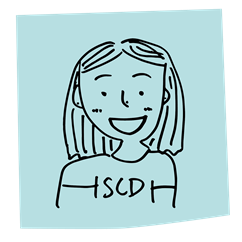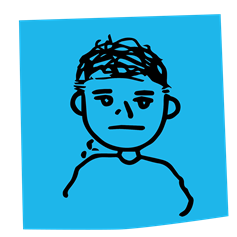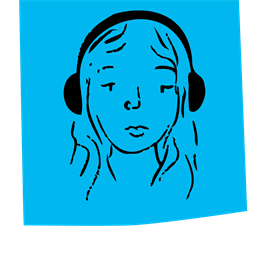4/30/2024
Celebrating Graphic Design - Proudest Project Showcase
Celebrating Graphic Design at SCD: Proudest Project Showcase
A peek into our graphic design team's design thinking process
Discover how HCD informs technical design
Read on to see how seven of our graphic design interns use empathy and iteration to brainstorm, strengthen, and bring their designs to life as they discuss their favorite projects they have made this past academic year.
Liz Coats, Graphic Designer
Signage and Pogs for UX Days 2024
"My ideation process came from reviewing the brand guidelines the intern team created for UX Days '24. Once colors, visual elements, and patterns were established, I was able to get inspiration from the other projects my peers were creating for the event to decide what layout and imagery I needed to include in the room signage and pog pieces. A prototype I developed for the Pog game was a set of circular pieces of cardboard. The team and I were able to play with these pieces to decide how user-friendly it was to learn the game, along with discussing which material would be appropriate for the final game pieces.
Some feedback I received was advice on what visual elements I should include when designing the signage and pog pieces to ensure a specific theme was established when looking at all of the UX Days '24 materials (fliers, name tags, etc.). In retrospect, I don't think I'd change anything about this project. I enjoyed being able to work with the intern team as we all came together and created different elements for one event. I am very proud of this project, and I feel a sense of connection with my community knowing I was creating a game and stickers for guests to use and enjoy."
Ty Villanueva, Lead Designer
Reading Day Spring 2024
"My ideation process included bouncing ideas off my team, sketching, and curating a vision board. During this process, I took inspiration from my Chicago culture. Something I specifically took a lot of inspiration from was Chicago grocery store signage. When first starting out, I quite literally depicted the items I envisioned at a grilling event like the grill itself, hot dogs, and a picnic blanket. As I kept revising my design and receiving feedback on what visual aspects were most important I tweaked my design to ensure a highlighted focus on the key aspect, the hot dogs, while still including my original playful design and loud typography.
If I could change something about the project for a new iteration, it would probably be trying different typography. The chosen typography is loud similar to Chicago grocery store signage, however, trying other variations could have strengthened the design."
Sarah Anderson, UX Researcher & Designer
SCD Tours App
"I started this project by researching self-guided tour apps and looking at elements that worked well with the SCD Tours concept. I also interviewed a variety of people ranging from SCD employees to visiting high school students to understand their preexisting knowledge of SCD, and what they would look for in a tour app. I categorized their findings into pain points and used those to inform what features would be useful in our tour app interface.
By using Figma for a prototype of the app screens, the design could be utilized for user testing of the app as if it was already fully developed and functioning. After developing the designs, I received feedback that made me realize we might have to go back and define the specific pain point and what we wanted to achieve for our audience. If I could go back, I would try to focus on the types of users we would see fit for this tour experience. Possibly users could even select between SCD staff member or visitor to get a more personalized experience. The staff could have interface options that can assist them when giving in-person tours, while the visitor section could be the completely self-guided option. Additionally, for the visitors, there could be an on-boarding process where users can select their specific interests, and the tour could highlight resources/opportunities that align with users interests, providing a personalized experience for users to visualize how they might use the space for themselves."
Pamé Martinez
ISAM Poster
"Beginning this project, I thought of how to best create something creative and appropriate for the International Symposium on Academic Makerspaces event. I collaborated with Ty and we looked at a lot of references for data visualization and STEM-oriented design. We played with a lot of different colors and images that were converted into ASCII-type images. As we worked, we had to switch some images around because they didn't translate well/didn't read well once converted, and we also had to switch our color palette and go with something a little less loud, which allowed the assets to take the stage more.
At some point, our coworkers said that some of the images looked strange which was great feedback because it hadn't been something I'd considered myself. My biggest challenge was when it came to the graphs in our first drafts. It was challenging to create graphs that were easily legible, creatively interesting, and that were spaced appropriately to allow for all the necessary information to fit without looking too busy/overwhelming. Collaborating with Ty on this project was really helpful here because we took different approaches to this challenge and he was able to find a really good creative solution. If I were to re-do this project, I think I would have allowed myself to play more with the entire composition of the poster. After I had figured out an iteration that worked, I just played within the rules of that composition. But I think it would have been really fun to try and create multiple compositions using all the same assets to see what came out of it. "
 Jaylon Cox, Designer
Jaylon Cox, Designer
Vestibule Poster
"As I started working, I primarily ideated ways to create an analogy centered around the idea of Human-Centered Design to explain it efficiently to people who may not be familiar with the idea. Seeing as the design was a poster, prototyping mostly involved iterations where the color and type were shifted slightly for easier readability and/or better overall function.
There were a few changes made to the design as per the request of supervisors and from the advice of peers like shifting the color of the headline text and the flow of the text. Originally, I had colored the "U" in "Human" a contrast of white instead of black like the rest of the word to exemplify the fact that HCD is about “you”, the human, but this was changed due to readability. My biggest challenge was working to fit the full definition of HCD on a poster seeing that it is a very large and holistic process. If I were to continue to tweak the design, I would focus on how the project could be expanded and make the visual elements seem to jump off the page so that they can better grab the attention of someone passing by."
Sumin Cho, Designer
Vestibule Poster
"This project was created to visually depict what Human-Centered Design and its different mindsets mean. In my brainstorming, I went on to create a lot of posters drawing inspiration from the Bauhaus era with many geometric shapes and the use of primary colors. Then, I started thinking of what Human-Centered Design means to me personally as a designer. To me, HCD is what provides the building blocks of my design. These blocks are the foundation I build my narrative upon as I go through any creative project. I really wanted to visually display this idea, so I sketched various 3D shapes that could act as representations of these building blocks and researched just the term “building block” to draw inspiration from and see if there was anything I wanted my project to head towards stylistically.
A challenge I ran into was having to include text into this project, and how that would affect the layout of the building blocks. As I iterated, I ended up keeping the original design and overshadowed it with a body of text. But after much consideration and feedback, I kept the design as it was originally and excluded the main body of text. Some of my biggest challenges included making sure the meaning of HCD was clear and delivered in a way that was understandable to my peers, and trying to incorporate text into the design. In retrospect, spending more dedicated time ideating and prototyping would have been extremely beneficial for allowing both text and shapes to be strong in the design, but I am very happy with how the project turned out despite this."
 Natalie Schneider, Lead Branding
Natalie Schneider, Lead Branding
Trick or Treat Event
"I initially started this design by adding Halloween aspects, like zombie hands and tombstones, to an image of the building. After creating my initial prototype, I decided to use a real photo of the building because I thought my first draft looked a bit too vectorized. I then added a black and orange gradient map which gave the building a spooky glow, and added other visual elements associated with Halloween like skeletons walking across the field and an over-sized moon.
The most helpful critique I got on this poster resulted in adding the blurb at the bottom that briefly explains the meaning behind Trick or Treat. This was added because a large population of students at UIUC are international students, and since they do not celebrate Halloween, they may not be familiar with the phrase “Trick or Treat”. This feedback allowed me to improve my design while keeping the general student audience it was made for central in my creative process."